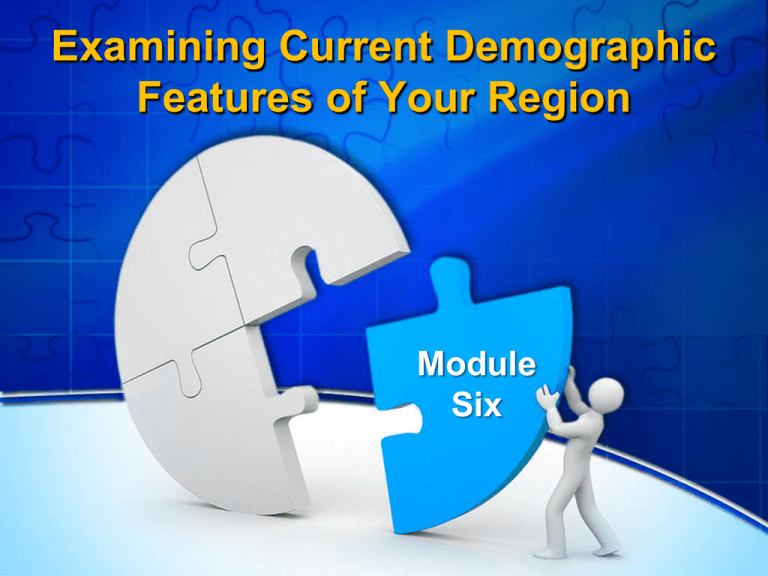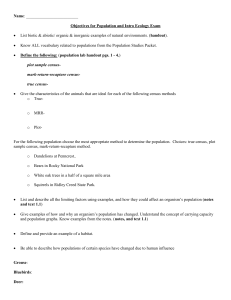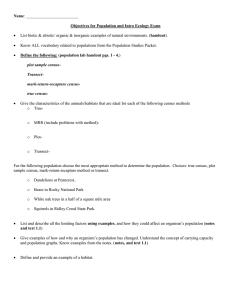Examining Current Demographic Features of Your Region Module Six
advertisement

Examining Current Demographic Features of Your Region Module Six Our Previous Module (Assets & Barriers) Update on homework related to Module Five. Any feedback on. . . Capacity inventory of individuals? Inventory of local associations & institutions? Community participation and leadership inventory? Subcommittee activities? Other items? Module Six Objectives • Understand secondary data and its limitations • Identify demographic variables that are important for regional planning • Know the characteristics of your workforce • Review the data in your region • Discover three to four “themes” in your region and how they impact your goals What Are Secondary Data? • Information sources that already exist • Data collected by someone else that are being “re-used” by others • In contrast, “primary data” are those that you have collected • Secondary data can be either qualitative or quantitative in nature Ways to Analyze Data Three Common Approaches: • Cross-sectional: Look at data at one point in time • Comparative: Examine the data in your county or region relative to other counties or regions • Longitudinal: Focus on how the data change over a longer time period What to Look for in Your Data • • • • Conditions that the data describe The direction of change The intensity of change The overall picture that the data paint about your county/region Understanding the Good & the Bad about Secondary Data The Good About Secondary Data • Already exist !! • Are less expensive • Take less time to assemble & analyze • Are easier to use The Bad! Secondary Data May. . . • • • • Have inconsistencies in definitions Be inaccurate, incomplete, or biased Have problems with “reliability” Be only indirect measures of the issues • May be outdated • Require caution in interpretation Questions You Should Consider • • • • • • • What is the source of the data? Does it cover the correct geographical location? Does it provide data on my target audience? Does it deal with my issue/topic of concern? Is it current data? Are the data available for the same time period? Are definitions of variables the same over time? Why Examine Conditions and Trends? • Help identify a region’s competitive advantage • Highlight important changes in residents and business/industry • Essential for understanding what has worked and what hasn’t worked in the past Regional Planning Variables •Performance Assessments •School Enrollment •Dropout Status •Educational Attainment •Population Size & Composition •Population Distribution •Migration Patterns •Population Change POPULATION •Climate LOCATION •Local taxes •Infrastructure •Cost of Living •Commuting Patterns •Natural Resource Amenities •Available Land & Buildings EDUCATION SOCIAL •Housing •Crime Rates •Poverty Status •Health Care Resources •Health and Nutrition Status •Food Assistance Enrollment •Child Care Access/Enrollment Population Characteristics Population Change, 2000-2009 Source: U.S. Census Population – Sources of Change Total Population Change Natural Increase Net International Migration United States 25,581,948 15,875,579 8,944,170 Northeast 1,688,851 1,877,814 1,835,442 - 2,539,582 Midwest 2,441,721 2,969,319 1,158,438 - 1,752,191 South 13,082,047 5,837,372 3,118,775 3,874,132 West 8,369,329 5,191,074 2,831,515 417,641 2000-2009 Source: U.S. Census Domestic Migration State Population Projections 2000-2030 Source: U.S. Census Population – Age Percent of the Total Population 65 Years and Over: 2009 Source: U.S. Census Population: Your Region • What can you conclude about trends in your region? • What are some overarching opportunities and concerns? Education Characteristics Population – High School Graduate or Less Source: U.S. Census Closing the Gap? In-School Success Source: National Assessment of Education Progress, 2010. http://www.nces.ed.gov/nationsreportcard/naepdata Education – Your Region • What can you conclude about trends in your region? • What are some overarching opportunities and concerns? http://factfinder.census.gov Location Characteristics Location – Cost of Living Composite Cost of Living (Scaled) 2nd Quarter 2010 Source: Missouri Economic Research and Information Center Location – Natural Amenities Source: Economic Research Service, USDA Location – Percent of Households with Broadband Access, 2000 Location – Percent of Households with Broadband Access, 2009 Location – Your Region • What can you conclude about trends in your region? • What are some overarching opportunities and concerns? Social Characteristics Social – Poverty in Rural America, 2008 Source: raconline.org Social – % Without Health Insurance, 2000 Social – % Without Health Insurance, 2009 Social – Change in Food Stamps (SNAP) Use by States, FY2005-2009 Social – Your Region • What can you conclude about trends in your region? • What are some overarching opportunities and concerns? Demographic Data Wrap Up • What are some of the overarching issues that you seen from the data you’ve analyzed? • Where are their areas of concern? Where are there possible opportunities? • How well to these concerns/opportunities align with your regional goals? Regional Workforce Your People Experience Skills Your Labor Force Willingness to work Training What else defines your labor force? How to Measure Experience? Skills Source: http://www.statsamerica.org/ Identifying Skills in the Region Example: Manufacturing Employed by this Industry Projected Projected Job Openings Growth (2008-2018) (2008-2018) Occupation 100% Pourers and Casters, Metal Decline rapidly 2900 100% Extruding and Forming Machine Setters, Operators, and Tenders, Synthetic and Glass Fibers Decline rapidly 1500 99% Textile Winding, Twisting, and Drawing Out Machine Setters, Operators, and Tenders Decline rapidly 5800 98% Computer-Controlled Machine Tool Operators, Metal and Plastic Average 36900 98% Lathe and Turning Machine Tool Setters, Operators, and Tenders, Metal and Plastic Decline rapidly 9100 98% Textile Bleaching and Dyeing Machine Operators and Tenders Decline rapidly 1700 100% Pourers and Casters, Metal Decline rapidly 2900 / Willing to Work? An important question! How do we measure willingness to work? • Labor force participation rates • Supplemental Security Income (SSI) & Disability Payments U.S. Labor Force Participation Supplemental Security Income (SSI) Recipients, 2009 Training • Institutions of Higher Education • Community Colleges • Technical Schools • Workforce Training Programs Workforce Influences • Is your region retaining the skills it creates? • What type of skills does your region attract? • Does your region attract retirees? Regional Workforce – Your Region • What can you conclude about trends in your region? • What are some overarching opportunities and concerns? Refining Regional Goals Given the secondary data you have explored: • Do your regional goals build on (or respond to) the population, social, education and location characteristics of your region? • How well to the goals take into account the characteristics of your region’s workforce • If not, what revisions should be made to your regional goals? Refining Regional Goals Current Goal 1 Goal 2 Goal 3 Goal 4 Revised Final Reflections What are the takeaways from this module? What topics did you find most helpful? What did you find confusing? What do you hope to implement as part of your regional team’s activities? Other items you want to mention? Looking Ahead: Module Seven Were going to examine the following: • Basic concepts of competitive advantage • Approaches to analyzing regional connections • Tools and data for detecting regional competitive advantage • Strategies for building stronger regional economies Additional Resources Census Data U.S. Census Bureau – Main Portal • http://www.census.gov/ – Census Bureau A-Z Subjects • http://www.census.gov/main/www/subjects.html – Census of Agriculture • http://www.nass.usda.gov/Census_of_Agriculture/index.asp – State and Metropolitan Area Data Book • http://www.census.gov/compendia/smadb/ – American Community Survey • http://www.census.gov/acs/www/ US Census QuickFacts http://quickfacts.census.gov SRDC Community Data Center http://srdc.msstate.edu/data/center/ American FactFinder http://factfinder.census.gov STATSAmerica http://statsamerica.org/profiles/us_profile_frame.html STATSAmerica http://statsamerica.org/innovation/anydata/index.asp




